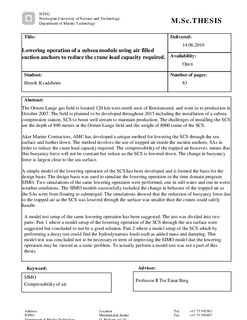Lowering operation of a subsea module using air filled suction anchors to reduce the crane load capacity required.
Master thesis
Permanent lenke
http://hdl.handle.net/11250/237785Utgivelsesdato
2010Metadata
Vis full innførselSamlinger
- Institutt for marin teknikk [3472]
Sammendrag
The Ormen Lange gas field is located 120 km west-north west of Kristiansund, and went in to production in October 2007. The field is planned to be developed throughout 2015 including the installation of a subsea compression station, SCS to boost well stream to maintain production. The challenges of installing the SCS are the depth of 890 meters at the Ormen Lange field and the weight of 8000 tonne of the SCS.
Aker Marine Contractors, AMC has developed a unique method for lowering the SCS through the sea surface and further down. The method involves the use of trapped air inside the suction anchors, SAs in order to reduce the crane load capacity required. The compressibility of the trapped air however, means that this buoyancy force will not be constant but reduce as the SCS is lowered down. The change in buoyancy force is largest close to the sea surface.
A simple model of the lowering operation of the SCS has been developed and it formed the basis for the design basis. The design basis was used to simulate the lowering operation in the time domain program SIMO. Two simulations of the same lowering operation were performed, one in still water and one in worst weather conditions. The SIMO models successfully included the change in behavior of the trapped air as the SAs went from floating to submerged. The simulations showed that the reduction of buoyancy force due to the trapped air as the SCS was lowered through the surface was smaller than the cranes could safely handle.
A model test setup of the same lowering operation has been suggested. The test was divided into two parts: Part 1 where a model setup of the lowering operation of the SCS through the sea surface were suggested but concluded to not be a good solution. Part 2 where a model setup of the SCS which by performing a decay test could find the hydrodynamics loads such as added mass and damping. This model test was concluded not to be necessary in term of improving the SIMO model due the lowering operation may be viewed as a static problem. To actually perform a model test was not a part of this thesis.
